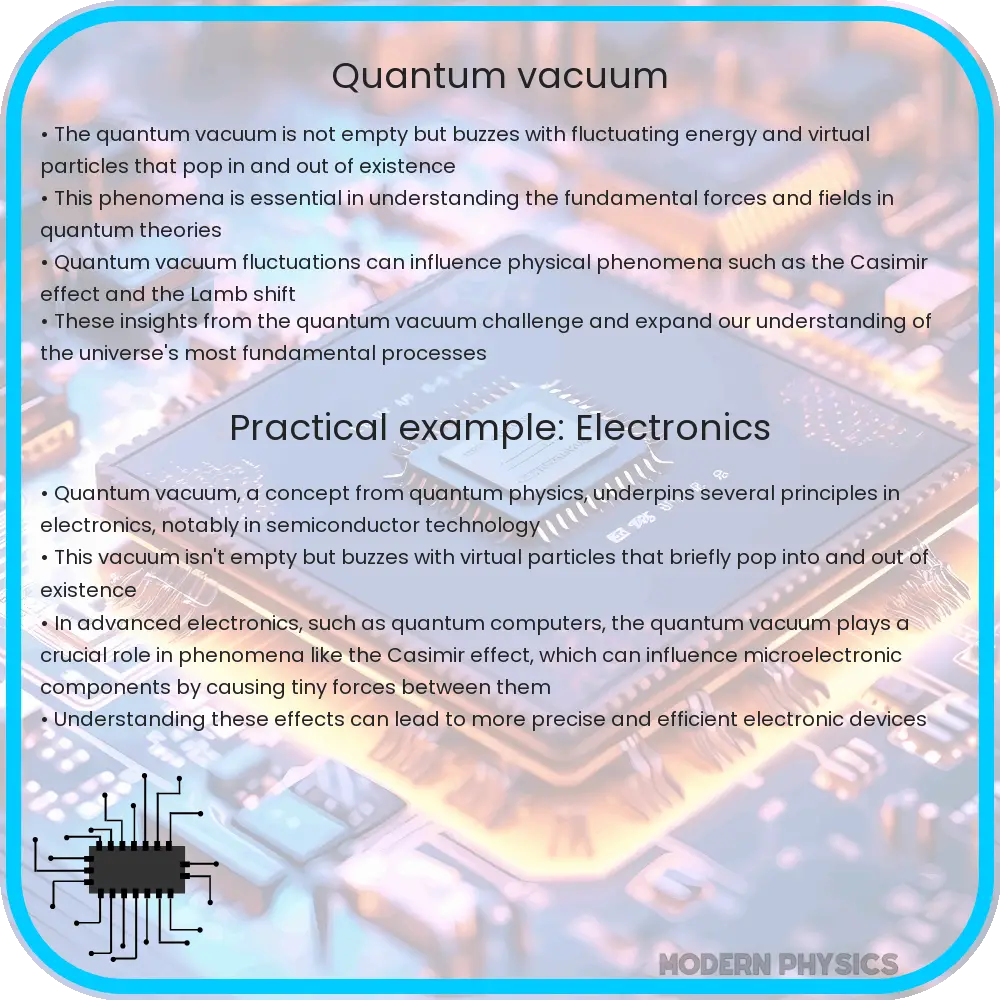Explore the enigma of the quantum vacuum, delving into quantum fluctuations, zero-point energy, and field dynamics in quantum field theory.

Exploring the Quantum Vacuum: Unveiling the Mysteries of Quantum Fluctuations, Energy, and Field Dynamics
The concept of a ‘quantum vacuum’ has intrigued scientists and philosophers alike for decades. Contrary to the classical notion of a vacuum as a void of emptiness, the quantum vacuum is a bustling arena of energy and dynamics. At the heart of this concept are quantum fluctuations, fundamental to our understanding of the universe at its most microscopic scale.
In quantum field theory, the vacuum state is not simply empty space. It is filled with virtual particles that constantly pop in and out of existence. These particles, though transient, have real effects. For example, the Casimir effect, where two uncharged metallic plates placed very close to each other in a vacuum experience an attractive force, can be attributed to the quantum fluctuations of the vacuum. This phenomenon illustrates the tangible influence of these fleeting particles.
Quantum Fluctuations: The Seeds of the Universe
Quantum fluctuations are essentially temporary changes in the amount of energy in a point in space, as allowed by the Heisenberg Uncertainty Principle. This principle posits that one cannot simultaneously know the exact position and momentum of a particle. Consequently, the energy of a system can fluctuate spontaneously, but these fluctuations are constrained by the energy-time uncertainty relation.
These fluctuations are not just theoretical constructs; they have real-world implications. For instance, during the inflationary phase of the early universe, quantum fluctuations are believed to have been magnified to macroscopic scales, leading to the large-scale structure of the universe we observe today. In essence, the inhomogeneities that gave rise to galaxies and galactic clusters can be traced back to these quantum beginnings.
Energy and Field Dynamics in the Quantum Vacuum
The quantum vacuum is also a source of energy. According to quantum mechanics, even in its lowest energy state, a quantum field possesses a non-zero energy, known as the zero-point energy. This concept challenges our classical understanding of energy and has implications for fields like cosmology and quantum gravity. The zero-point energy of the vacuum has been hypothesized to play a role in the cosmological constant, a term in Einstein’s equations of general relativity that is associated with the accelerated expansion of the universe.
Furthermore, the dynamics of fields in the quantum vacuum are governed by quantum field theory. This framework extends the probabilistic nature of quantum mechanics to fields, allowing for the creation and annihilation of particles. This constant activity within the vacuum gives rise to a rich tapestry of interactions and phenomena, fundamentally altering our conception of the void.
The Enigmatic Zero-Point Energy
One of the most fascinating aspects of the quantum vacuum is the concept of zero-point energy. This is the lowest possible energy that a quantum mechanical physical system may possess, and unlike in classical mechanics, it is non-zero. This energy is inherent in all quantum systems and contributes to various physical phenomena. For instance, zero-point energy is fundamental in understanding the behavior of atoms at absolute zero temperature where, according to classical physics, motion should cease. Instead, due to zero-point energy, atoms exhibit a residual movement.
Zero-point energy also offers intriguing possibilities in the field of quantum mechanics and cosmology. It has been speculated as a potential source of vast, untapped energy, often referenced in discussions about futuristic energy technologies. However, harnessing this energy remains a subject of theoretical exploration and practical challenge.
Quantum Field Theory: A Deeper Dive
Quantum field theory (QFT) provides a more comprehensive picture of these quantum vacuum phenomena. It treats particles as excited states of an underlying physical field, so that even when particles are not present, the field exists with its zero-point energy. QFT has been successful in integrating quantum mechanics with special relativity and in explaining the creation and annihilation of particles, a cornerstone in understanding fundamental interactions in physics.
One of the triumphs of QFT is its ability to describe the electromagnetic, weak, and strong nuclear interactions, encompassing a vast range of phenomena from the subatomic to the cosmic scale. The predictions of QFT have been tested to an incredible degree of accuracy, making it one of the most successful theories in the history of physics.
Conclusion: The Unseen Universe
The study of the quantum vacuum and its associated phenomena like quantum fluctuations, zero-point energy, and field dynamics offers a glimpse into the profound complexities of the universe at its most fundamental level. These concepts challenge our traditional notions of empty space and energy, opening new horizons in both theoretical and applied physics. From explaining cosmic phenomena to the potential of new energy sources, the exploration of the quantum vacuum continues to unravel the mysteries of the universe, reminding us that even in apparent emptiness, there is a world of unseen activity and endless possibilities. The quantum vacuum is a testament to the depth and wonder of the natural world, a subject that will undoubtedly continue to fascinate and inspire scientists for generations to come.
